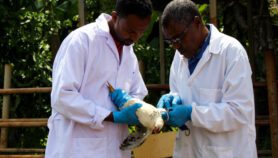By: Tharaka Gamage
Send to a friend
The details you provide on this page will not be used to send unsolicited email, and will not be sold to a 3rd party. See privacy policy.
[COLOMBO] Sri Lankan scientists have begun work on a detailed strategy to implement the country’s first national science and technology policy, whose approval lay in limbo for decades while the country was engaged in internal conflict.
After protracted discussions that began in 1980s, the policy was formally approved by Sri Lanka’s cabinet in July 2009, shortly before the country’s civil war was officially declared at an end.
It calls for increasing investment in science from 0.13 per cent of the country’s GDP to 1.5 per cent by 2016, and its objectives include the promotion of basic and applied sciences for national development, sustainable resource management and adaptation to climate change.
"We are putting together an integrated action plan," Nalini Ratnasiri, chair of Sri Lanka’s National Science and Technology Commission (NASTEC) and a zoology professor at the Open University of Sri Lanka, told SciDev.Net.
She said that various science and technology institutes in the country would be involved in working out the implementation strategy. "We have to work together with other ministries and institutes to fulfill this task," she said, adding that "through continuous conferencing we will take ideas from everyone".
The implementation plan was launched at NASTEC’s sixth national conference on science and technology last month (16–18 July) in Kandy, and Ratnasiri said a report on the implementation will be released soon.
Sri Lanka’s science and technology minister, Tissa Vitharana, a former scientist, told SciDev.Net that the action plan would need to be completed by the middle of September if the country’s 2011 general budget can allocate the required funds.
"To start the plan we need at least 0.4 per cent of GDP [devoted to research]. I hope that amount will be granted because the war is now over," Vitharana said.
Discussions on Sri Lanka’s need for a coherent science policy began in the 1980s. A presidential taskforce was appointed in 1991 to look into science policy, and a ministry of science and technology was launched in 1994.
Also in 1994, the country passed a science and technology development act, and set up two science organisations: a National Science Foundation to fund science projects and NASTEC to draw up policy. But the civil war delayed further progress at the time.
Among the new policy’s aims are fostering a science, technology and innovation culture that reaches out to all citizens; improving the resource base of scientists and technologists; developing sustainable use of natural resources for development; and promoting the application of science and technology for human welfare; disaster management and adaptation to climate change.













